‘Artfelt’ need
If you stand in a certain spot, it looks as though the man is teetering dangerously close to a precipice, which drops into a dark abyss. No one is concerned by this.
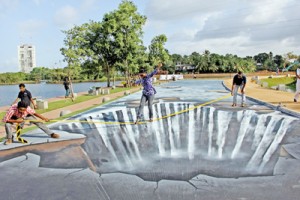
Amazingly real: Sudath Abeysekara’s 3D art at Diyatha Uyana
A toddler cheerfully rides her tricycle while her mother keeps a watchful eye and close by, a group of teenagers huddle together for a selfie.
The man stands even closer to the precipice, tilting forward precariously and feigns an expression of surprise for the camera. His friend, standing directly opposite, gives a thumbs up sign to signal that the picture was taken and they swap places.
There’s evident pleasure on Sudath Abeysekara’s face when he sees people enjoying the 3D art he painted on the walking paths at Diyatha Uyana.
He helpfully points out an icon of a small yellow camera painted on the ground and explains that would be the optimum point to experience the illusion of the 3D art, to the two youngsters about to take the picture – “the illusion works well through the lens of a camera,” he explains to them.
Stopping to examine the art, he ruefully acknowledges that it is in need of a touch up. The painting is slightly faded now, worn out by sun, footfall and vigorous cleaning.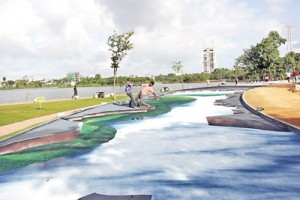
The 3D illusions painted on the walking paths vary – one is of fissures in the earth, one is a cavernous hole which falls into darkness and the other, portions of the shore jutting out into gushing water.
Sudath, a full time artist, explains that the 3D art was done in 2012 and took three months to complete with the help of a team of university students and 20 artistically inclined Navy personnel.
Painting it was a challenge. By 2012, 3D art had gained popularity abroad but was new territory for Sudath and his team of artists. A new type of paint was experimented with and a trial work was painted in a car park before they undertook the work in Diyatha Uyana.
Done free of charge, the enthusiastic artists would come in the evening and continue well into the night to complete the work.
There’s a thin line which blurs the distinction between public art and street art – they’re both freely available to be consumed by the public after all.
One is commissioned work done by specific artists, chosen by relevant authorities or commissioning bodies – the 3D art at Diyatha Uyana, for instance, or the startling sculpture in Central Colombo, of a fist emerging from the earth, clutching an old fashioned telephone.
The other, usually unsanctioned, is more spontaneous and has a shorter lifespan. Both, when inculcated carefully, are equally important to a city’s visual identity and artistic acumen.
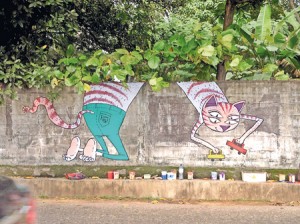
Cat caught your eye? Ruwangi Amarasekera’s playful mural at Rajagiriya. Pic by Adilah Ismail
Public art can range from amusing and irreverent to impactful and thought provoking and has gained popularity over the world.
Cities have recognised the impact and importance of cultivating unique visual identities and have taken steps to develop artistic talent and in some cases, effectively use it as a tourism tool.
The art ranges from interactive installations and sculptures to memorials and murals – the possibilities are seemingly endless.
There’s been a distinct effort to carve out Colombo’s visual identity and while large scale efforts have been slow, there’s an undercurrent of energetic artists excited to discover the creative pulse of their city and forge a contemporary Sri Lankan artistic identity.

Lording over the Arcade: Dayananda’s lions and (inset) the artist at work with his assistants in his workshop in Kurunegala
From the Sigiriya rock, the guardian lions of Yapahuwa to the National Flag, the emblem of the lion is intertwined through the trajectory of Sri Lankan art and Sri Lankan history.
To carve the family of lions, portrayed in the sculpture at the Independence Arcade, Dayananda Muhandiram studied hours of footage of African lions.
Projecting the footage on a large surface, he would pore over seemingly innocuous details, examining the movements and moods of the lions to help sharpen the minutiae of the sculpture.
The relevant authorities wanted to portray the symbol of the lion – associated with symbols of power, pride, might and courage –inside the shopping arcade. And so the artist was commissioned to use an age-old emblem to sculpt the zeitgeist of a post-war country, emerging from conflict.
To do this, Dayananda who is a lecturer at the Faculty of Visual Arts in Colombo, portrayed the pride of lions in varying moods. One is watchful, awake and alert, ears pricked up in anticipation.
Another tired and resting while another lion quenches its thirst.To depict the many moods of the lions, Dayananda explains that he turned to elements of cubism with undercurrents of realism and Russian inspired influences.
Working out of a workshop in Kurunegala, it took 100 days for Dayananda along with a team of assistants and craftsmen, to slowly sculpt a pride of five lions from large, shapeless slabs of stone.
Carved out of mudstone from Madagalla, the lions were carved separately and then assembled together in Colombo.
With new exciting mediums to experiment with in the art world, Dayananda emphasises that city planners need to take into account art when planning and include more public art into city narratives.
Niruban Satchithanandakumar would like to get his hands on the sprawling canvas that Marine Drive offers. A self-taught, experimental artist, Niruban is a part of the P413 mob – a group of young adults interested in art who have come together to create art in public spaces.
The overarching theme governing their work is to make their art as playful, quirky and colourful as possible and the group constantly experiments with multiple genres.
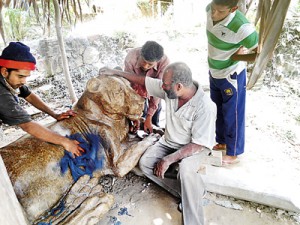
Over the years the P413 mob has adopted a trial and error approach to their art, experimenting with video and UV lights, papier mache, murals and even attempted to break a Guinness world record. The P413 mob operate in large groups and a part of their artistic appeal is the collaborative and democratic approach to art.
The group brings together individuals ranging from IT, finance to engineering.Not everyone is artistically inclined but they’re all bound together by an enthusiasm to create art. Says Niruban: “We’re an art group where not everyone is an artist but we still figure out a way to make art. I think for me, personally, that’s the most exciting thing.
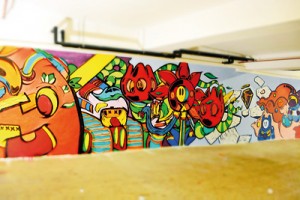
Quirky and playful: A mural with the stamp of P413
Working with a mob means that you work with people who don’t consider themselves artists, to make art.”
The name P413, Niruban explains, comes from the Bible- Philippians 4:13 – “I can do all things through Christ who strengthens me”. The verse is a particularly personal one as Niruban is acutely aware of his self-taught status in the art world.
“I feel like a fraud sometimes. It’s like going and getting tax advice from a guy who is not a tax accountant,” says Niruban bluntly, “I don’t have any learning, background in design or art. I just winged it off the internet.”
There are certain lines drawn in the sand and the group is careful not to cause offence or paint on private houses or company property without permission.
Niruban comments on the interest of corporates in supporting a culture of creativity and which is useful for artists to survive – costs are a constant problem, art supplies aren’t cheap.
While the interest is welcome and the street art scene is gradually expanding, Niruban worries if this is just a fad which will fade in a couple of years and stresses that Sri Lankan art needs to stay relevant if it wants to go beyond mere novelty and outlive the latest cultural trend.
He emphasises that dedicated spaces within cities to create art, commissioning work from emerging artists and encouraging initiatives such as public pop-up exhibitions would go a long way in helping.
Ruwangi Amarasinghe dreams of painting an outsized mural on the side of a building but laughingly admits that it’ll be a while before she’ll be able to do something on that scale.
The freelance illustrator has been experimenting with street art for a little over a year now. She confesses that at times, being a female artist can pose a challenge when trying to paint on the street without getting too much attention from curious onlookers.
For now, Ruwangi’s own art is visible in Trincomalee, on Obeysekarapura Road in Rajagiriya – a colourful, playful piece– as well as the Rio Cinema.
She explains that the old, abandoned Rio Cinema in particular, was a dream location as the art within it brought a brief flicker of life back into the building.
“I think people mistake graffiti as street art,” muses Ruwangi explaining that the easy conflation between both have sometimes made people sceptical of street art, which isn’t necessarily confined to graffiti and can be done in a respectful manner.
For Ruwangi, street art helps break the monotony of urban space and brings pockets of individuality on the walls and a fragment of the artist embedded into the city. She believes that being confronted with art in easily accessible public spaces helps people open their minds and is emphatic in her wish to see more art on the streets by other artists.
Moving forward, the artist hopes to highlight more socially conscious themes and focus on issues through her work.
As we wrap up our conversation, a water monitor lizard lazily ambles across the path, making its way past the 3D art. “Cities are built by men and then governed by men,” says Sudath looking out into the distance.
“The same way we build buildings, we also need to build up art, culture and develop people’s understanding of art beyond entertainment,” he stresses adding that there is plenty of talent around the country, lacking the opportunity to be nurtured and harnessed. “Art is important to a city.”


